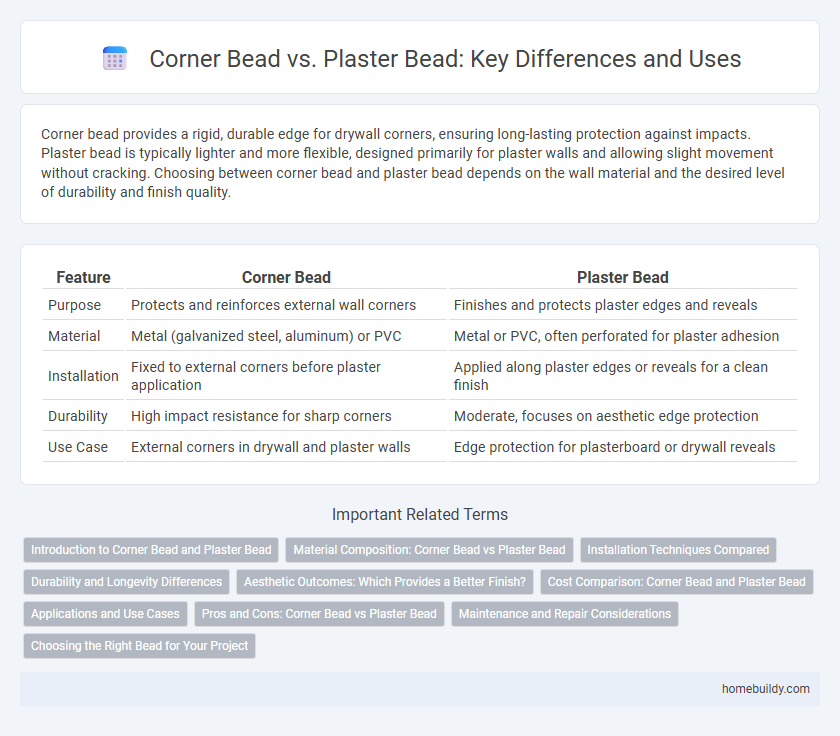Corner bead provides a rigid, durable edge for drywall corners, ensuring long-lasting protection against impacts. Plaster bead is typically lighter and more flexible, designed primarily for plaster walls and allowing slight movement without cracking. Choosing between corner bead and plaster bead depends on the wall material and the desired level of durability and finish quality.
Table of Comparison
| Feature | Corner Bead | Plaster Bead |
|---|---|---|
| Purpose | Protects and reinforces external wall corners | Finishes and protects plaster edges and reveals |
| Material | Metal (galvanized steel, aluminum) or PVC | Metal or PVC, often perforated for plaster adhesion |
| Installation | Fixed to external corners before plaster application | Applied along plaster edges or reveals for a clean finish |
| Durability | High impact resistance for sharp corners | Moderate, focuses on aesthetic edge protection |
| Use Case | External corners in drywall and plaster walls | Edge protection for plasterboard or drywall reveals |
Introduction to Corner Bead and Plaster Bead
Corner bead is a rigid metal or plastic strip used to reinforce and protect the edges of drywall corners, providing a sharp, clean finish. Plaster bead, made from metal or vinyl, serves as a guide for plaster thickness and helps create smooth, straight edges on plaster walls. Both beads prevent cracking and chipping but are selected based on material compatibility and desired corner strength.
Material Composition: Corner Bead vs Plaster Bead
Corner beads are typically made from galvanized steel, aluminum, or PVC, offering high durability and resistance to impact, while plaster beads are commonly composed of metal or plastic with a mesh backing to enhance adhesion to plaster surfaces. The rigid structure of corner beads provides strong edge protection and clean lines for drywall corners, whereas plaster beads are designed to accommodate the flexible nature of plaster finishes. Material composition directly influences the application suitability, with metal corner beads favored for drywall and plaster beads preferred for traditional plaster walls.
Installation Techniques Compared
Corner bead installation typically involves fastening metal or plastic strips to drywall corners using nails, screws, or adhesive, followed by applying joint compound for a smooth finish. In contrast, plaster bead installation requires embedding the bead into wet plaster with careful alignment to ensure a crisp edge, often demanding more skill and time. The chosen technique impacts durability and corner sharpness, with plaster beads offering a seamless integration, while corner beads provide quicker, more straightforward application for drywall projects.
Durability and Longevity Differences
Corner bead, typically made from metal or rigid PVC, offers superior durability compared to plaster bead, which is usually softer and prone to chipping. The galvanized steel or aluminum construction of corner bead ensures resistance to impact, moisture, and corrosion, extending the lifespan of wall corners significantly. In contrast, plaster bead may deteriorate faster in high-traffic areas, requiring more frequent repairs or replacements.
Aesthetic Outcomes: Which Provides a Better Finish?
Corner bead and plaster bead both enhance wall edges but differ in aesthetic outcomes, with corner bead offering a sharper, cleaner finish ideal for modern, crisp angles. Plaster beads tend to create a softer edge, blending more subtly with textured or traditional plaster finishes. The choice depends on the desired visual effect, with corner bead favored in contemporary designs for its precise, polished appearance.
Cost Comparison: Corner Bead and Plaster Bead
Corner bead generally costs less than plaster bead due to its simpler manufacturing process and common use in drywall applications. Plaster bead, often made from more flexible materials like metal or vinyl with decorative profiles, tends to have a higher price point reflecting its specialty in plaster wall finishing. Budget-conscious construction projects prefer corner bead for affordability, while plaster bead is favored for aesthetic finishes despite the increased cost.
Applications and Use Cases
Corner beads are primarily used to reinforce and protect external corners in drywall installations, ensuring sharp, clean edges and preventing damage from impact. Plaster beads, on the other hand, are designed for plaster walls and are ideal for controlling moisture and providing a smooth finish around window reveals, archways, and other detailed plasterwork. While corner beads excel in high-traffic areas requiring durability, plaster beads are preferred in decorative or moisture-prone environments for enhanced aesthetic finishes and water resistance.
Pros and Cons: Corner Bead vs Plaster Bead
Corner bead offers superior durability and impact resistance, making it ideal for protecting wall corners in high-traffic areas, while plaster bead provides a smoother finish but is less robust against physical damage. The metal or vinyl materials used in corner bead ensure long-lasting reinforcement compared to the thinner, often flexible plaster bead which can be prone to chipping. However, plaster bead excels in aesthetic integration and ease of installation for intricate designs, whereas corner bead requires more precise fitting and finishing work.
Maintenance and Repair Considerations
Corner beads, typically made from metal or rigid plastic, offer superior durability and resistance to impact compared to plaster beads, making them easier to maintain over time. Plaster beads, being more fragile, often require frequent touch-ups and repairs due to cracking or chipping, increasing maintenance efforts. Choosing corner beads minimizes repair frequency and reduces long-term maintenance costs in drywall installations.
Choosing the Right Bead for Your Project
Corner bead provides durable edge protection and a clean finish for drywall corners, making it ideal for areas prone to impact. Plaster bead, often used for plaster surfaces, offers a more flexible option with a textured edge, better suited for traditional plaster walls. Selecting the correct bead depends on the substrate and desired durability, ensuring optimal adhesion and long-lasting results for your project.
corner bead vs plaster bead Infographic

 homebuildy.com
homebuildy.com